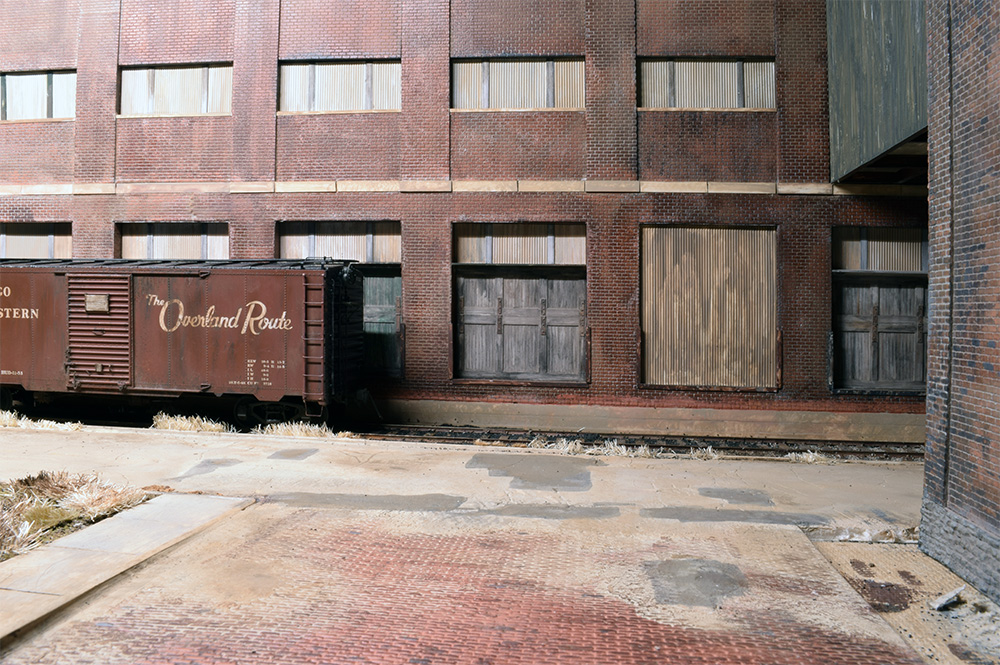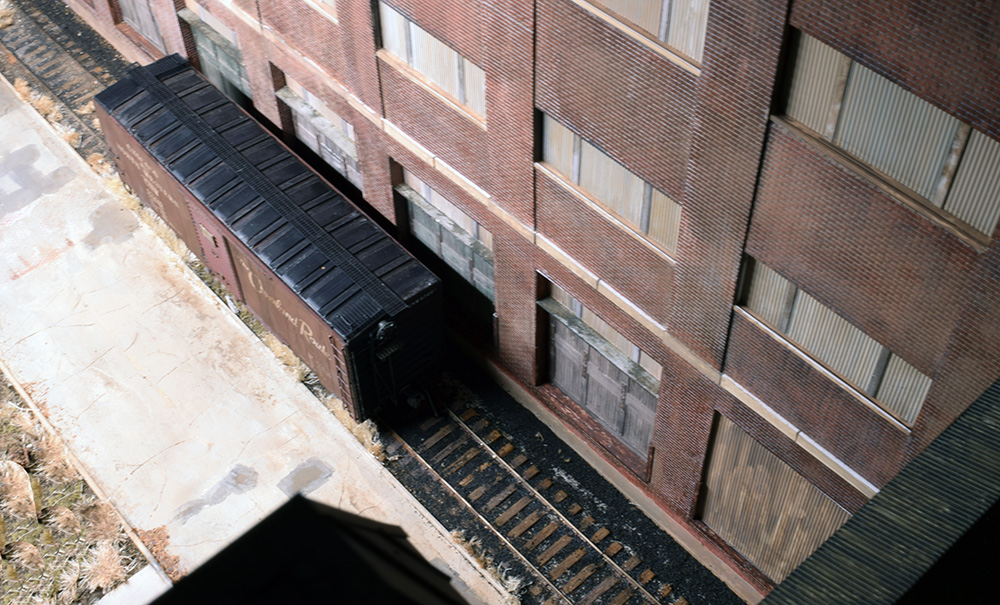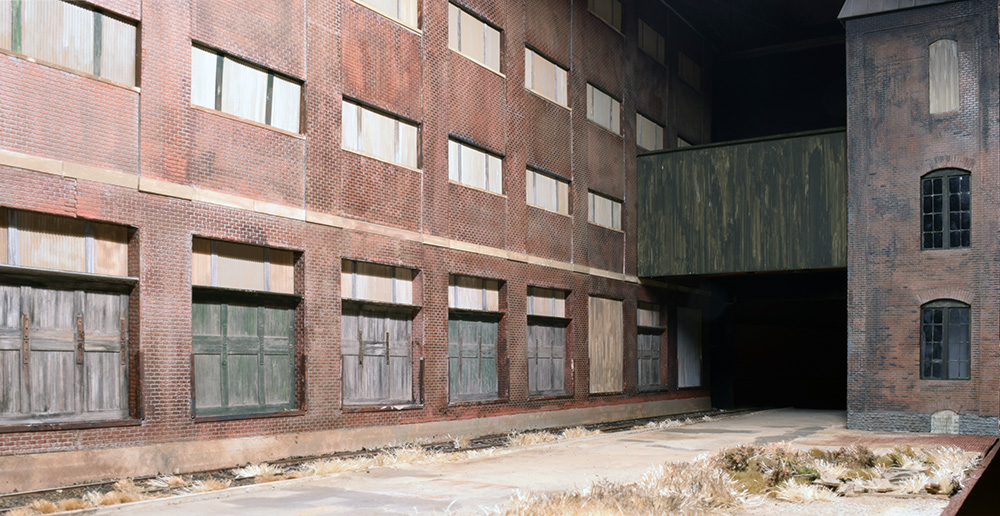
The Trinity covered hopper car is on hold while I wrap up the major details for the 13th and North E cameo. I’ve completed both buildings and the connector between them. I want to debut the cameo as a work in progress at the St Louis RPM this month and while there are many smaller details still to come, this brings the major construction to a close.
As an experiment in using quarter-inch scale in a small space, I’m pleased with how the 15 x 48 inch scene feels. A significant part of its impact is from the lack of compression. Each building is modeled to full-scale dimensions, yet you only see a portion of each. This selective editing focuses your attention. The mass of the buildings gives a sense of enclosure and the density of an urban setting. These aren’t “boxcar buildings” that are barely larger the rail cars; they tower over the siding, putting each in scale to the other.

The warehouse works as a backdrop because the edges aren’t seen. You know it’s a flat façade, yet the lack of depth isn’t obvious. In composing the scene, I eliminated the horizon and the sky. This massive building surrounds you and defines the space. Where each building meets the fascia, I use color to minimize the visual impact of these artificial areas and to draw your eye back into the scene.
The vacant lot provides much needed contrast and context to the mass of the buildings. This open corner balances the congested nature of the tunnel like alleyway where North E Street and the siding exit the scene. It’s the front row seat where you can orient yourself and view the action.
I often suggest that each modeling scale has a natural viewpoint. Here, I’ve drawn you in close, so P48 can do what it does best: showcase the detail it’s known for. I’m using the natural strength of the scale to enhance the realism it’s capable of.

Representing space and distance are the twin dragons we all deal with. People seldom if ever question the mindset that we have to depict as much distance as the room space will allow. To do this, we compress everything down and use a ridiculous number of tricks to layer in more, often at the expense of practicality or common sense.
At shows in the past, HO modelers will look at a turnout I’ve brought and immediately sift it through the only filter they have: a room size HO layout. Compared to that, the size of P48 is a jolt to the system initially. It was for me and required a lot of time to adjust. At first, all you see is the sacrifices you have to make to do the same thing in quarter-inch. Most can’t make the mental leap. What I really hope this cameo does is provoke the beginning of a conversation about quarter-inch scale and ways to move past the stereotypes around it.
Do I really need to model the entire journey this boxcar has taken? Would the horrendous artificial compression I’d have to use speak as clearly about the size and scope of the railroad? For me, the answer is no. This little 1:48 corner of the world speaks powerfully for itself.
Mike
As usual I agree with you and enjoy your thoughts Mike.
As you know I model in both 1/25th and 1/87th. Probably sharing my model time 50/50. I like that HO provides a way to turn out models that can look good but the expectations are kept for typical layout viewing height and distance. I tend to model my “small” scale projects to that as well. Which has its own place and the value of not becoming overwhelming year long projects.
When I model in 1/25th though, I hope people stop and take a look closer. Stick their nose down close. There is detail that would not show up in smaller scales. Or if so would be very tough to keep in scale. But with a larger project, I like people needing to stop for a second. Then relate to what they are seeing. Each bolt has a nut on the other side,even if each are just casting and not holding anything they are there because they should be. Same with items like corrosion on battery terminals. In HO to even show up it would be grossly oversized. But in 1/25th it is not only there, but it has texture and white and green and blue colors like the real thing.
I enjoyed at the RPM in St Louis a couple years ago somebody actually noticed the side of the drivers seat in a model truck was worn through to the foam. He said “Every old truck has that from the driver sliding on it” it makes projects more real to someone when things like that can be related to I think.
See you in a couple weeks, hope the diorama is there with you guys.
Hi Steve,
I like that you make the point about how each scale is different and should be taken individually. There’s a tendency for people to treat every scale by the same rules, which is lazy in my view. N scale has different aspects than HO or 1:48. By the time you get up to the scale of your vehicles, it’s a different beast altogether. I’m still in awe of your logging truck from a couple of years ago. That model wouldn’t be nearly as nice in 1:48 as it is at 1:25. I’m still planning on bringing the cameo even though it isn’t finished, so stop by when you get a moment.
Mike
“The best scale to model in, is the largest you have space for.” – Donald Boreham.
But that rather begs the question: what do you want to model?
If you want to model “operations” and paperwork, then a smaller scale with extensive trade support is indicated, although to be honest, all you really need is a chair, a desk and a computer! If you want to model individual items faithfully, then larger is better, especially if you are not particularly concerned with operating or indeed even movement.
It’s also a question of time and money, as well as space. It is always possible – if not always easy – to do something about increasing money or space, but time is irreversible, so it is best used wisely (he said, not actually doing anything constructive!)
The great thing about building individual models in a larger scale is that they actually require less space – no basement empire required, a display shelf or maybe a diorama to set the scene. Doesn’t require many tools, either.
Simon
Simon,
I’ve found working in quarter-inch scale more satisfying than HO for a number of reasons. The primary one is the degree of focus it imposes. The cliche’ about space in this scale is one you ignore at your own risk, until you understand what the strength of the scale actually is. It’s easy to produce a caricature instead of a scale model.
Mike